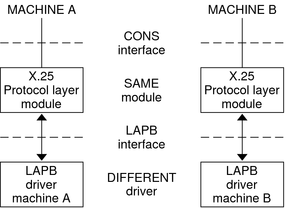| Skip Navigation Links | |
| Exit Print View | |

|
STREAMS Programming Guide |
Part I Application Programming Interface
Communicating With a STREAMS Device
How STREAMS Works--Application Interface
How STREAMS Works at the Kernel Level
Structure of a STREAMS Device Driver
Configuring Multiplexed Streams
2. STREAMS Application-Level Components
3. STREAMS Application-Level Mechanisms
4. Application Access to the STREAMS Driver and Module Interfaces
7. STREAMS Framework - Kernel Level
8. STREAMS Kernel-Level Mechanisms
11. Configuring STREAMS Drivers and Modules
14. Debugging STREAMS-based Applications
B. Kernel Utility Interface Summary
With STREAMS, you can manipulate modules from the user application level, interchange modules with common service interfaces, and change the service interface to a STREAMS user process. These capabilities yield further benefits when working with networking services and protocols:
User-level programs can be independent of underlying protocols and physical communication media.
Network architectures and higher-level protocols can be independent of underlying protocols, drivers, and physical communication media.
Higher-level services can be created by selecting and connecting lower-level services and protocols.
The following examples show the benefits of STREAMS capabilities for creating service interfaces and manipulating modules. These examples are only illustrations and do not necessarily reflect real situations.
Figure 1-6 shows how an X.25 protocol module can work with different drivers on different machines by using compatible service interfaces. The X.25 protocol module interfaces are Connection Oriented Network Service (CONS) and Link Access Protocol – Balanced (LAPB).
Figure 1-6 Protocol Module Portability

You can alternate protocol modules and device drivers on a system if the alternates are implemented to an equivalent service interface.
Figure 1-7 shows how STREAMS can move functions between kernel software and front-end firmware. A common downstream service interface lets the transport protocol module be independent of the number or type of modules below it. The same transport module will connect without modification to either an X.25 module or X.25 driver that has the same service interface.
By shifting functions between software and firmware, you can produce cost-effective, functionally equivalent systems over a wide range of configurations. This means you can swiftly incorporate technological advances. The same transport protocol module can be used on a lower-capacity machine, where economics preclude the use of front-end hardware, and also on a larger scale system where a front-end is economically justified.

Figure 1-8 shows the same canonical module (for example, one that provides delete and kill processing on character strings) reused in two different streams. This module would typically be implemented as a filter, with no service interface. In both cases, a TTY interface is presented to the stream's user process because the module is nearest the stream head.
